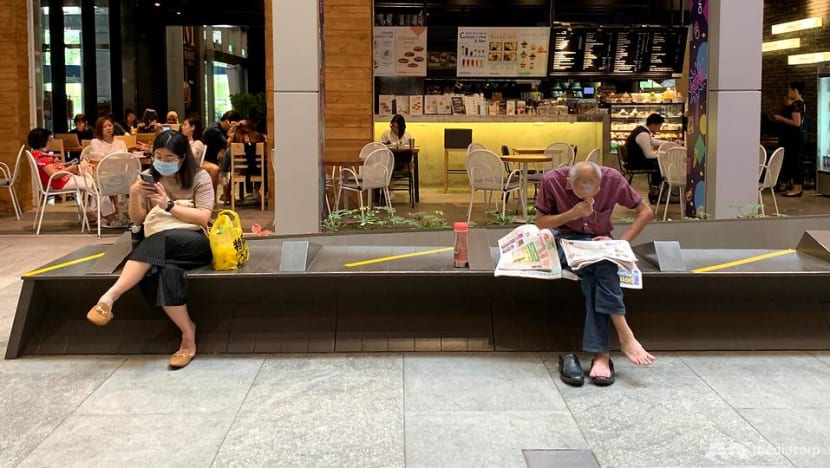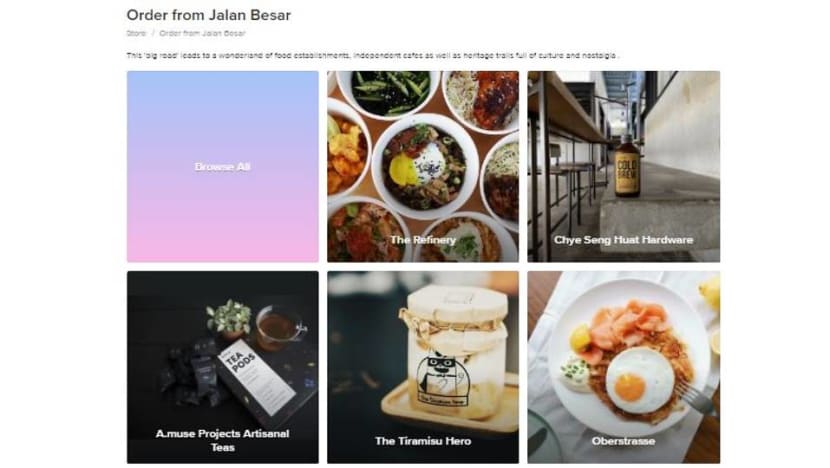commentary Commentary
Commentary: The biggest restructuring exercise facing Singapore businesses has just begun
From F&B to retail and fitness, winning Singapore businesses know they must shift gears and rethink their business models to thrive in a pandemic economy, says NUS Business School’s Lawrence Loh.

People queue to enter a mall, as mall capacity is regulated in a series of safe distancing measures to curb the outbreak of COVID-19 in Singapore Mar 27, 2020. (Photo: Reuters/Edgar Su)
SINGAPORE: After hunkering down under circuit breaker conditions for two months amid a relentless COVID-19 crisis, businesses already grappling with a collapse in demand must now shift gears.
While many had hoped for a reversion to normalcy after Jun 2, the Government’s three-phase approach to reach a “new normal” announced this week signalled a vastly different outlook for the foreseeable future.
Waiting out the coronavirus can no longer be strategy. For businesses that can restart more operations, things will not be the same. Those good old days are gone.
Physical interaction has traditionally underpinned economic activity, but that assumption has all but vanished with safe physical distancing needed among customers and employees. Even in phase 3, new ways of doing business and fresh revenue sources must be sought.
So how should businesses adapt, and more importantly, how can they continue to win in this grim setting?
READ: Commentary: Malaysia succeeded in suppressing COVID-19 but here comes the harder part
READ: Commentary: New Singapore Government measures must be more targeted than previous three Budgets
Leaders in three high-profile human-centric Singapore sectors – retail, food and beverages, and fitness – show how business models must change to find winning formulas.
RETAIL: FOCUS ON THE SERVICES, LESS THE GOODS
Even before circuit breakers kicked in, the retail sector in Singapore was already seeing declines in shop occupancy rates. Vacancies rose to 8 per cent in the first quarter, up from 7.5 per cent in the previous quarter.
In March, Singapore’s retail sales suffered the biggest plunge in 22 years, with key items like clothes and footwear taking the most severe hit.
Yet, today, some bright spots have emerged. Mothercare, a specialised British retailer catering to expectant mothers, babies and young children, has bucked the trend in Singapore.

While overall revenue has declined some 70 per cent since the beginning of the circuit-breaker, its online sales have more than quadrupled compared year-on-year.
The retailer, with 11 outlets here, also made an interesting transition from a purely brick-and-mortar shop to an online entity.
Beyond having a website, Mothercare Singapore has a digital nursery advisory that provides expert help on various aspects of being motherhood – from maternity to birth and after – and the relevant range of products that aid that journey. Customers can book an appointment online and ask about coaching, consultation and perks.
Notably, the average shopping basket size of those using the advisory service is thrice that of a regular online order. If anything, the innovative online retail experience alleviates one of the greatest headaches of shopping: Decision-making.
READ: Commentary: Has COVID-19 made e-commerce and online shopping the new normal?
More fundamentally, in moving into services with the nursery advisor idea, Mothercare is changing the idea of what is expected of a retailer.
The Singapore chain is now thinking of scaling up. It has partnered Lazada, a dominant e-commerce platform, to have a strong presence on LazMall.
Furniture store Scanteak also moved strongly into online sales during the circuit breaker. Riding on its projection that people will need fit-for-purpose furniture when mandated to work from home, it saw payoffs in doubling down on digitalisation
While creating a dedicated platform may seem like a less attractive option for smaller, less recognisable retailers, riding on established e-commerce platforms can be a quick way to make that digital leap.
Retailers can tap on Amazon, Lazada, Qoo10 or Shopee to reach customers in existing and new markets. Enterprise Singapore ‘s E-commerce Booster Package already provides subsidies on up to 90 per cent of related costs.

The sum difference lies, however, in complementing that with customer engagement to provide a winning experience.
EATING: FIND YOUR FANBASE, CREATE A RALLY PONT
F&B outlets probably face the greatest challenge as the economy restarts. Dining-in and safe distancing are not natural companions. Eating in will probably take a prolonged hit.
Even in March, before circuit breaker measures kicked in, F&B sales plunged 23.7 per cent year-on-year. Chope reported that 42 per cent of restaurants would not survive beyond two months and 81 per cent will not last beyond six.
Many F&B joints are closing down, almost like falling dominoes – from Italian bar-restaurant Jekyll and Hyde to Japanese joint Hashida Sushi. This growing list includes hawkers.
READ: Commentary: I miss my regular bar – but I accept I might never get to return, even after circuit breakers are lifted
READ: Commentary: We are becoming a 'dabao nation' – why does it feel like a bad thing?
Where many refuse to go quietly into the night, some are banking on a strategy of engaging their most ardent supporters. Mr Melvin Chew, a duck rice seller at Chinatown Complex Food Centre, started a Facebook group to promote fellow hawkers online. Called the Hawkers United – Dabao 2020, this platform currently has 265,000 members comprising hawkers, customers and delivery providers.
This simple hawker alliance is a win-win. It cuts through delivery apps’ high commission rates as hawkers can connect directly to the customers.
More than a “super app”, it is a fantastic idea for hawker fans wanting something different every now and then, where recommendations posted each day push new options so customers do not have to search.
And it is not just hawkers. On the other end of the spectrum is FOODHOOD which plays to hipsters and younger customers who frequent the Jalan Besar area for popular eateries like Chai Seng Huat Hardware and The Refinery.

The big take-away is this: Know your fanbase and create a rally point for them. This one-stop concept for organising and pooling is a winning formula – involving restructuring at the product distribution level.
FITNESS: CREATE COMPELLING CONTENT, BUILD A COMMUNITY
More people aim to get the perfect circuit breaker body but the fitness sector, gyms and studios, may not be the same again.
During the circuit breaker period, fitness providers can no longer provide physical sessions or locations for exercise.
But Boom Singapore, a boxing exercise provider, was quick to adapt. It put up live Zoom packages and a subscription to archived classes with a few membership tiers. Sign-up has been made easier with a walkthrough video on Instagram.
These cater to the growing demand for home workouts during the circuit breaker.
READ: Commentary: You can enjoy jogging even by yourself
READ: Commentary: Evidence obesity a risk factor for serious illness with coronavirus is mounting
Lululemon, a yoga apparel company, similarly shifted towards partnerships with ambassadors and fitness professionals to provide digital classes in yoga, pilates, dance and more – with offerings listed on Eventbrite.
These efforts are aimed at churning out sufficiently engaging content, so customers return each day online and see themselves as part of a specific group. The hope is once circuit breaker fully lifts, these fitness firms would have built robust, loyal relationships that encourage customers to go to their gyms or buy their products.

The fitness sector has been forced to adopt a new business function out of sheer necessity: The creation of compelling content that provides a value proposition to customers and builds community.
RESTRUCTURING FOR THE FUTURE
The possibilities are unlimited as seen in these three sectors, each of which have identified new growth opportunities, retooled themselves and reorientated their people to take up new tasks.
There is one commonality across them: Digitalisation that allows them to reach customers instead of expecting them to come to you.
As Deputy Prime Minister Heng Swee Keat prepares to unveil a fourth package of support for businesses on Tuesday (May 26), firms should take draw inspiration from these stories to reimagine, restructure and ready themselves for a post-pandemic future.
LISTEN: Disruption 101: How COVID-19 is revolutionising work
BOOKMARK THIS: Our comprehensive coverage of the coronavirus outbreak and its developments
Download our app or subscribe to our Telegram channel for the latest updates on the COVID-19 outbreak: https://cna.asia/telegram
Lawrence Loh is director of Centre for Governance, Institutions and Organisations at NUS Business School where he is also associate professor of strategy and policy















